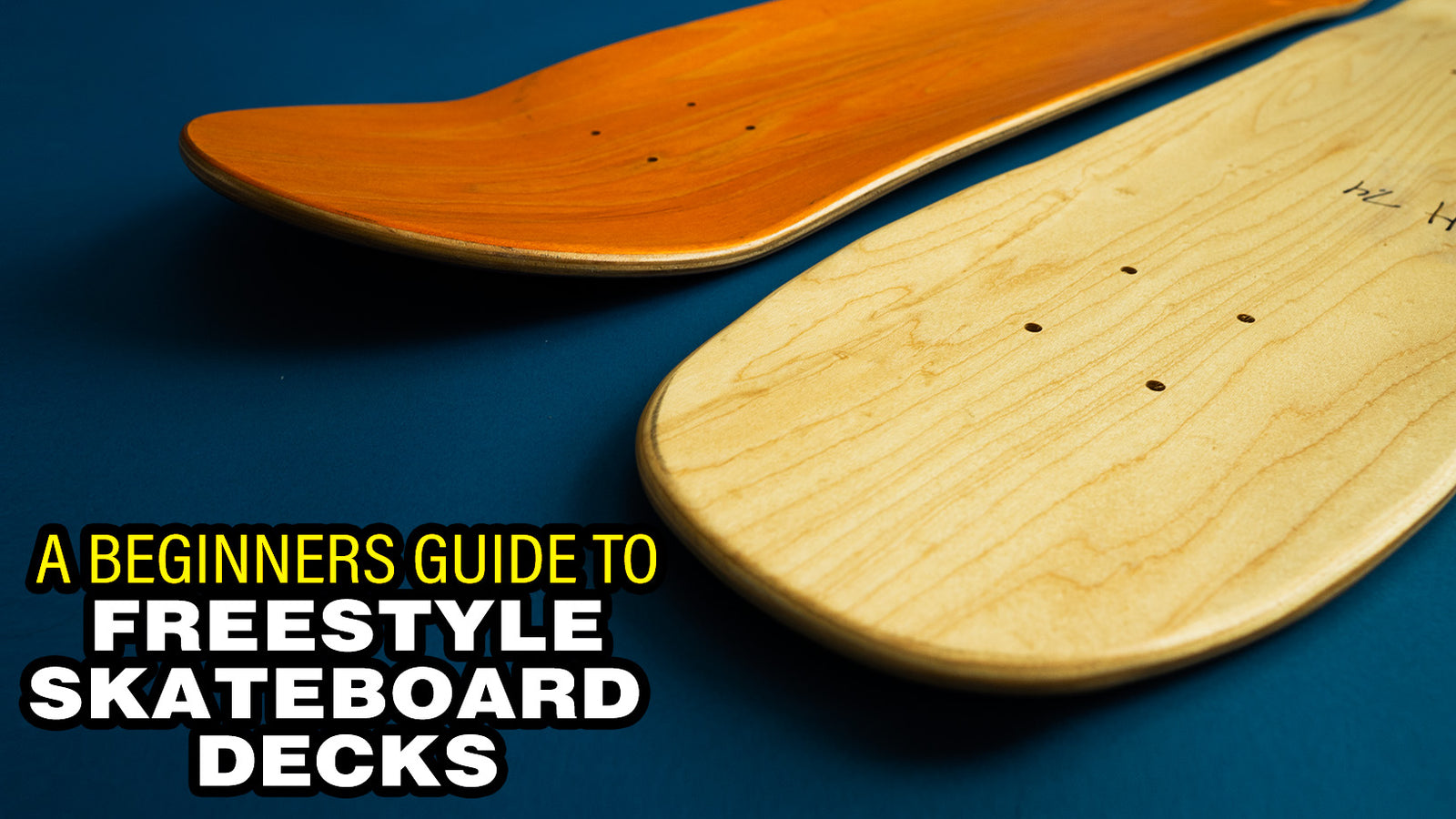Freestyle skateboarding decks come in a range of sizes and shapes. Before you decide which board will be the best freestyle skateboard deck for you, it's important to understand how we measure a board.
Dimensions

Length - The distance from the tip of a skateboard's nose and the end of a skateboard's tail. Freestyle skateboard decks are usually 26" - 30" long.
Width - Freestyle skateboard decks are usually 7.25" - 8" wide.
Wheelbase - The distance between the front truck bolts and rear truck bolts. Freestyle skateboard wheelbases are usually 11.5" - 13.75" long.
Nose - The front section of a skateboard, usually measured from the front truck bolts to the front of the board.
Tail - The back section of a skateboard, usually measured from the rear truck bolts to the end of the board.
Double Kick vs. Single Kick
 Although freestyle skateboard decks come in many unique shapes, most decks feature one of two "kick" styles - Double kick or single kick
Although freestyle skateboard decks come in many unique shapes, most decks feature one of two "kick" styles - Double kick or single kick
"Kick" - This refers to the upturned nature of a tail or nose.
Double Kick - A double kick freestyle skateboard that has an upturned nose and upturned tail. Many freestyle skateboarders prefer double kick decks for learning freestyle footwork tricks, ollie tricks, and shuvits. Double kicks tend to make pogos, caspers, and fingerflips more difficult.
Single Kick - A single kick freestyle skateboard that has an upturned tail and flat nose. Classic freestyle skateboarding tricks like pogos, caspers, finger flips, and some wheelies tend to be easier when done with a flat nose. Rail flips (primo flips) may bounce higher and slower. Some people find that their ollie tricks suffer when they switch to a single kick skateboard deck. Some single kicks tend to feel less responsive or "soggy" due to their lack of concave.
Spoon Nose - The Waltz Spoon Nose skateboard offers the strengths of a single kick skateboard deck -- Easy pogos and caspers, high rail flips, etc. -- with added rigidity and ollieability. A slight kick nose and continuous tub concave prevents the board from feeling soggy or lifeless.
Concave

Concave refers to the longitudinal curvature of the skateboard deck. The Waltz freestyle skateboard shop offers decks in a range of concave heights and styles. In general, decks for freestyle skateboarding are mellower than the average street or vert skateboard.
Profiles (a.k.a. Shapes)
A freestyle skateboard shape can be symmetrical or asymmetrical.
Symmetrical - The nose and tail have the same dimensions, kick angles, and profile. This means that your board will look and feel the same whether you are riding it with the nose or tail facing forward.
Asymmetrical - The nose and tail have differing dimensions and/or profiles. In freestyle skateboarding, some tricks might be easier on a square shaped tail. Other tricks might be easier on a round tail. Asymmetrical boards are designed to offer both options. Some skateboard builders refer to these as "swiss army knife" boards.
Skid Plates
You may have seen a freestyle deck and wondered "What are those plastic things on the nose and tail?"
Skid Plates - Abrasion resistant guards that can be mounted on the underside of the nose and tail of a skateboard to prevent wear.
Why Use Skid Plates? - Freestyle skateboard tricks involve a lot of tail dragging. Skid plates protect the tail of your skateboard from damage caused by tail drags and help you to avoid "razor tail".

